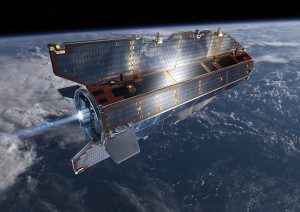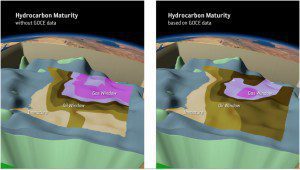
GOCE orbit is so low that it experiences drag from the outer edges of Earth’s atmosphere. The satellite’s streamlined structure and use of an electric propulsion system counteract atmospheric drag to ensure that the data are of true gravity. (Credit: ESA/AOES Medialab)
Data from the European Space Agency (ESA) GOCE gravity satellite are being used to improve models of Earth's geology, indicating the potential locations of subsurface energy sources.
The satellite known as the Ferrari of space has measured Earth's gravity with unrivalled precision, thanks to its extraordinarily low orbit about 255 kilometers high, about 500 kilometers lower than most Earth-observation satellites.
At the end of 2012, low fuel consumption allowed operators to extend the mission's life and start to lower the satellite a further 31 km for even more accurate measurements. This was at the very limit of its capability, but maximized the return for science.
Although GOCE's mission ended in October 2013, the gravity data from this super-low orbit has improved our understanding of Earth's interior, including identifying areas where oil and gas might be present.
3D models of Earth's underground are traditionally based on information acquired on the ground. Gravity data from the GOCE satellite, however, provide homogeneous coverage in high resolution, which is being used to improve and validate models based on traditional datasets.
Models based on GOCE data show subsurface density and its vertical and lateral variability, which provides insight into varying geological compositions and temperatures. Estimating the structure and thermal state of Earth's crust provides clues into the heat of shallower sedimentary rocks, and thus the potential location of oil and gas accumulations.
Subsurface areas with temperatures ranging over 60“200ºC indicate the maturity of the rock and, therefore, the likelihood of the presence of oil and gas.

3D models of Earth's subsurface are traditionally based on information acquired on the ground. Gravity data from the GOCE satellite, however, provide homogeneous coverage in high resolution, which is being used to improve and validate models based on traditional datasets. (Credit: Planetary Visions)
Using GOCE data for improving our understanding of Earth's composition is still in an early phase, and more local geophysical surveys need to be conducted to validate the models, said Jörg Ebbing from Germany's University of Kiel and one of the experts in the GOCE+ Geoexplore project, which carried out the study.
To promote the use of GOCE data for geophysical studies, the GOCE+ Geoexplore team has generated a set of global gravity gradients datasets at 225 km and 255 km altitudes that can be freely accessed through this link.

